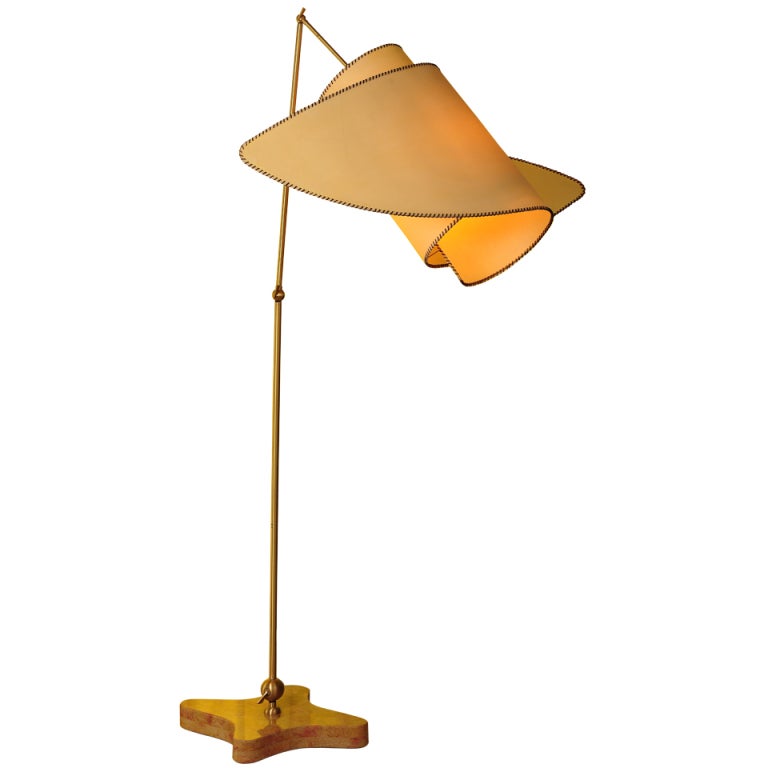Carlo Mollino

Carlo Mollino (May 6, 1905 – August 27, 1973) was an Italian architect and designer, born in Turin, Piedmont. As he grew up, Carlo Mollino became interested in a variety of topics that were as outrageous as his art, such as design, architecture, the occult, and race cars. He was once credited as saying, "Everything is permissible as long as it is fantastic." That credo was certainly reflected throughout his body of work. Mollino's architecture and furniture are famous for their ability to enable occupants to manipulate volumes at a whim.
Chosen Furniture
Three models have been created from Mollino's furniture. The first object is Cavour Desk, an inspirational centrepiece to any room or office,made with a thick, plate glass top and a sturdy oak wood frame. Designed with an intended floating appearance, this is an absolute must for any lover of individual and artistic furniture. The second object is Gilda Armchair, an armchair provided with frame in oak-dyed ash, bronzed-brass hardware, upholstery in polyurethane/Dacron Du Pont and leather cover. The third object is Suora Lamp, that was re-produced since 1994 by Edizioni Galleria Colombari as a reproduction of the original Cadma Lamp. In 1994, Edizioni Galleria Colombari began to produce the line “Homage to Carlo Mollino”, which includes reproductions of key pieces of Mollino’s oeuvre.
Project
Cavour Desk
 The idea for the model realization was to decompose the object in parts: legs, drawers, table and links for the different parts.
The legs profile was created drawing bezier curves, as shown in the plasm.js code below, and then drawing surfaces from these curves. Once created the profile, it was extruded to generated the 3D model, then duplicated and disposed as in the picture.
The idea for the model realization was to decompose the object in parts: legs, drawers, table and links for the different parts.
The legs profile was created drawing bezier curves, as shown in the plasm.js code below, and then drawing surfaces from these curves. Once created the profile, it was extruded to generated the 3D model, then duplicated and disposed as in the picture.
var point1 = [[1.94, 0, 4.78], [2.89, 0, 5.86], [1.73, 0, 5.34], [6.71, 0, 5.46]];
var c1 = BEZIER(S0)(point1);
var curve1 = MAP(c1)(domain);
var point2 = [[2.48, 0, 5.08], [2.35, 0, 5.55], [4.13, 0, 5.34], [5.01, 0, 5.39]];
var c2 = BEZIER(S0)(point2);
var curve2 = MAP(c2)(domain);
var surface1 = MAP(BEZIER(S1)([c1,c2]))(domain2D);
The drawers were created using the SIMPLEX_GRID function in order to re-create as much accurated and detailed the appearance of drawers. Even for the table was used the SIMPLEX_GRID function.
Links are very important in the model because they connect the entire stucture of the desk and were implemented as cylinders properly located.
In the pictures below are shown how the model was developed in Plasm.js and all its details.


Gilda Armchair

The armchair was divided into sub-parts to realize its model in a very detailed way: the upper part, the lower part of the armchair, the arms and some other details like bolts and machanism to set the armchair gradient.
The two parts of armchair and the arms were realized by drawing the profile bezier surfaces, with the same principle used for Cavour Desk, subsequently extruded with differents depth.
The bolts are well disposed to hold togheter arms and armchair. They were realized by bezier surfaces using circumferences with different radius.
In the pictures below are shown how the model was developed in Plasm.js and all its details.


Suora Lamp
 Even the lamp model is structured in sub-parts: the lampshade, the pedestal, nodes and links of the structure and mechanism to let links to change angulation.
The lampshade wad realized componing two surfaces modeled like in the pictured using the bezier function. Nodes that stay between links are realized by a custom sphere function, while links are cylinder properly rotated and translated.
The pedestal profile was realized using the bezier function but having curves with less control points like illustrated in the code below:
Even the lamp model is structured in sub-parts: the lampshade, the pedestal, nodes and links of the structure and mechanism to let links to change angulation.
The lampshade wad realized componing two surfaces modeled like in the pictured using the bezier function. Nodes that stay between links are realized by a custom sphere function, while links are cylinder properly rotated and translated.
The pedestal profile was realized using the bezier function but having curves with less control points like illustrated in the code below:
var point1 = [[0.7, 0, 0], [1, 1, 0]];
var c1 = BEZIER(S0)(point1);
var curve1 = MAP(c1)(domain);
var point2 = [[0, 0.7, 0], [1, 1, 0]];
var c2 = BEZIER(S0)(point2);
var curve2 = MAP(c2)(domain);
var point3 = [[0, -0.7, 0], [-1, -1, 0]];
var c3 = BEZIER(S0)(point3);
var curve3 = MAP(c3)(domain);
var point4 = [[-0.7, 0, 0], [-1, -1, 0]];
var c4 = BEZIER(S0)(point4);
var curve4 = MAP(c4)(domain);
var surface1 = MAP(BEZIER(S1)([c1,c3]))(domain2D);
var surface2 = MAP(BEZIER(S1)([c2,c4]))(domain2D);
surface3 = STRUCT([surface1,surface2]);
In the pictures below are shown how the model was developed in Plasm.js and all its details.

